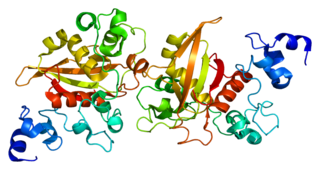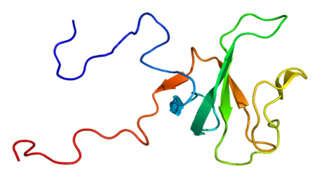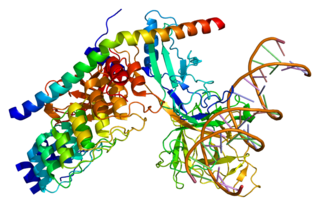
Neurogenic locus notch homolog protein 3(Notch 3) is a protein that in humans is encoded by the NOTCH3 gene.

Neurogenic locus notch homolog protein 1(Notch 1) is a protein encoded in humans by the NOTCH1 gene. Notch 1 is a single-pass transmembrane receptor.

Neurogenic locus notch homolog 4(Notch 4) is a protein that in humans is encoded by the NOTCH4 gene located on chromosome 6.

Neurogenic locus notch homolog protein 2 is a protein that in humans is encoded by the NOTCH2 gene.

The CYLD lysine 63 deubiquitinase gene, also termed the CYLD gene, CYLD is an evolutionary ancient gene found to be present as far back on the evolutionary scale as in sponges. In humans, this gene is located in band 12.1 on the long arm of chromosome 16 and is known to code multiple proteins through the process of alternative splicing.

CREB-regulated transcription coactivator 1 (CRTC1), previously referred to as TORC1 (Transducer Of Regulated CREB activity 1), is a protein that in humans is encoded by the CRTC1 gene. It is expressed in a limited number of tissues that include fetal brain and liver and adult heart, skeletal muscles, liver and salivary glands and various regions of the adult central nervous system.

Tribbles homolog 3 is a protein that in humans is encoded by the TRIB3 gene.

Sal-like protein 4(SALL4) is a transcription factor encoded by a member of the Spalt-like (SALL) gene family, SALL4. The SALL genes were identified based on their sequence homology to Spalt, which is a homeotic gene originally cloned in Drosophila melanogaster that is important for terminal trunk structure formation in embryogenesis and imaginal disc development in the larval stages. There are four human SALL proteins with structural homology and playing diverse roles in embryonic development, kidney function, and cancer. The SALL4 gene encodes at least three isoforms, termed A, B, and C, through alternative splicing, with the A and B forms being the most studied. SALL4 can alter gene expression changes through its interaction with many co-factors and epigenetic complexes. It is also known as a key embryonic stem cell (ESC) factor.

Transducin-like enhancer protein 3 is a protein that in humans is encoded by the TLE3 gene.

Protein deltex-2 also known as E3 ubiquitin-protein ligase DTX2 is an enzyme that in humans is encoded by the DTX2 gene.

AT-rich interactive domain-containing protein 2 (ARID2) is a protein that in humans is encoded by the ARID2 gene.

Slit homolog 1 protein is a protein that in humans is encoded by the SLIT1 gene.

Mastermind-like protein 1 is a protein that in humans is encoded by the MAML1 gene.

Protein deltex-1 is a protein that in humans is encoded by the DTX1 gene.

Protein ariadne-1 homolog is a protein that in humans is encoded by the ARIH1 gene.

Mastermind-like protein 2 is a protein that in humans is encoded by the MAML2 gene.

WD repeat-containing protein 62 is a protein that in humans is encoded by the WDR62 gene.

Transcription factor HIVEP3 is a protein that in humans is encoded by the HIVEP3 gene.

Notch proteins are a family of type-1 transmembrane proteins that form a core component of the Notch signaling pathway, which is highly conserved in metazoans. The Notch extracellular domain mediates interactions with DSL family ligands, allowing it to participate in juxtacrine signaling. The Notch intracellular domain acts as a transcriptional activator when in complex with CSL family transcription factors. Members of this Type 1 transmembrane protein family share several core structures, including an extracellular domain consisting of multiple epidermal growth factor (EGF)-like repeats and an intracellular domain transcriptional activation domain (TAD). Notch family members operate in a variety of different tissues and play a role in a variety of developmental processes by controlling cell fate decisions. Much of what is known about Notch function comes from studies done in Caenorhabditis elegans (C.elegans) and Drosophila melanogaster. Human homologs have also been identified, but details of Notch function and interactions with its ligands are not well known in this context.

Nanos homolog 1 (Drosophila) is a protein that in humans is encoded by the NANOS1 gene.


















